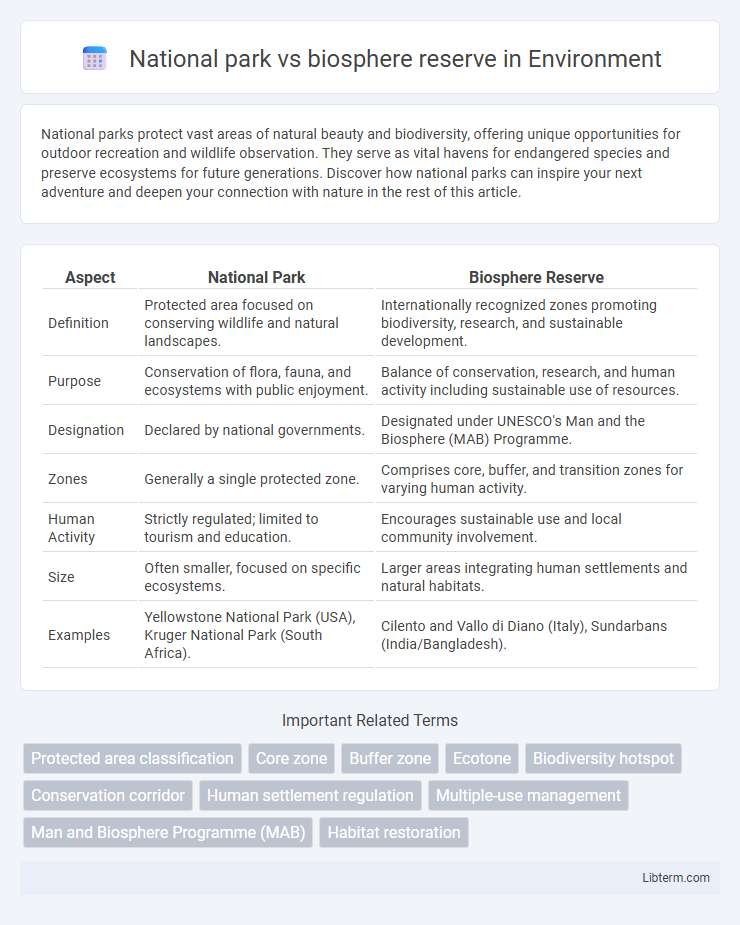National parks protect vast areas of natural beauty and biodiversity, offering unique opportunities for outdoor recreation and wildlife observation. They serve as vital havens for endangered species and preserve ecosystems for future generations. Discover how national parks can inspire your next adventure and deepen your connection with nature in the rest of this article.
Table of Comparison
| Aspect | National Park | Biosphere Reserve |
|---|---|---|
| Definition | Protected area focused on conserving wildlife and natural landscapes. | Internationally recognized zones promoting biodiversity, research, and sustainable development. |
| Purpose | Conservation of flora, fauna, and ecosystems with public enjoyment. | Balance of conservation, research, and human activity including sustainable use of resources. |
| Designation | Declared by national governments. | Designated under UNESCO's Man and the Biosphere (MAB) Programme. |
| Zones | Generally a single protected zone. | Comprises core, buffer, and transition zones for varying human activity. |
| Human Activity | Strictly regulated; limited to tourism and education. | Encourages sustainable use and local community involvement. |
| Size | Often smaller, focused on specific ecosystems. | Larger areas integrating human settlements and natural habitats. |
| Examples | Yellowstone National Park (USA), Kruger National Park (South Africa). | Cilento and Vallo di Diano (Italy), Sundarbans (India/Bangladesh). |
Introduction: National Parks vs Biosphere Reserves
National Parks are protected areas established primarily for the conservation of wildlife and natural landscapes, promoting recreation and education. Biosphere Reserves aim to balance biodiversity conservation with sustainable human activity, integrating ecological preservation with socioeconomic development. Both play crucial roles in environmental protection, yet Biosphere Reserves emphasize harmonizing nature conservation with community involvement.
Defining National Parks
National parks are protected areas established primarily for the conservation of wildlife, natural landscapes, and public enjoyment, often managed by national governments through strict regulations. These parks prioritize ecological integrity and recreational activities while limiting human impact to preserve biodiversity. Unlike biosphere reserves, national parks typically emphasize preservation over sustainable development and human habitation.
Understanding Biosphere Reserves
Biosphere reserves are designated areas recognized by UNESCO that integrate conservation of biodiversity with sustainable use of natural resources, balancing ecological protection with human activities. Unlike national parks, which primarily focus on preserving wilderness and wildlife, biosphere reserves include core protected zones surrounded by buffer and transition areas to support research, education, and sustainable development. This zonation allows biosphere reserves to serve as living laboratories for studying ecological processes and promoting harmonious coexistence between humans and nature.
Core Objectives: Conservation vs Sustainable Development
National parks primarily focus on strict conservation of ecosystems and wildlife, safeguarding biodiversity by limiting human activities and preserving natural habitats. Biosphere reserves integrate conservation goals with sustainable development, promoting harmonious interaction between humans and nature through controlled resource use and community involvement. This approach ensures long-term ecological health while supporting economic and social needs of local populations.
Legal Frameworks and Protection Levels
National parks are established under stringent legal frameworks prioritizing ecosystem preservation and public recreation, often with strict regulations on human activities to maintain biodiversity. Biosphere reserves operate under international frameworks like UNESCO's Man and the Biosphere Programme, combining conservation with sustainable use of natural resources and community involvement, resulting in zoning that balances core protected areas, buffer zones, and transition areas. Protection levels in national parks are typically higher with limited resource extraction allowed, whereas biosphere reserves implement flexible protection measures that integrate conservation goals with socio-economic development.
Zonation: Management Approaches Compared
National parks implement strict zonation to protect core wildlife habitats, restricting human activities primarily to buffer zones and designated tourist areas for conservation and recreation balance. Biosphere reserves adopt a more flexible zonation approach, dividing the area into core, buffer, and transition zones that integrate conservation with sustainable development and community involvement. This layered management ensures biodiversity preservation while promoting research, education, and resource use tailored to local socio-economic conditions.
Biodiversity Conservation Priorities
National parks prioritize strict protection of ecosystems to preserve native species and natural habitats with minimal human interference, focusing on maintaining ecological integrity and promoting biodiversity conservation. Biosphere reserves integrate biodiversity conservation with sustainable development, balancing ecosystem protection with research, education, and community involvement to support both conservation and human livelihoods. Conservation priorities in biosphere reserves emphasize adaptive management, habitat restoration, and monitoring of species diversity to enhance resilience across core, buffer, and transition zones.
Human Activities: Restrictions and Allowances
National parks enforce strict regulations limiting human activities such as logging, mining, and hunting to preserve ecological integrity and biodiversity. Biosphere reserves balance conservation with sustainable human activities like eco-tourism, research, and traditional resource use, integrating local communities in management practices. Both designate core protected zones, but biosphere reserves include buffer and transition areas allowing varying degrees of sustainable human intervention.
Global Examples and Case Studies
National parks like Yellowstone in the USA protect vast ecosystems primarily for conservation and recreation, while biosphere reserves such as the Cerrado in Brazil integrate sustainable development with biodiversity preservation. The Serengeti National Park in Tanzania exemplifies large-scale wildlife protection focusing on tourism and habitat integrity, whereas the UNESCO-designated New Biosphere Reserve in the Mediterranean balances agriculture, tourism, and conservation efforts. Case studies from these global sites reveal how national parks emphasize strict protection zones, and biosphere reserves implement adaptive management to harmonize human activities and natural resource conservation.
Conclusion: Choosing the Right Conservation Model
Selecting between a national park and a biosphere reserve depends on conservation goals and human activity integration; national parks emphasize strict biodiversity protection with limited human interference, while biosphere reserves balance ecosystem preservation with sustainable development and community involvement. Effective conservation requires aligning management strategies with ecological priorities, local socio-economic conditions, and long-term sustainability objectives. Decision-makers must evaluate habitat significance, species protection needs, and the potential for research and education to implement the most suitable conservation model.
National park Infographic

 libterm.com
libterm.com